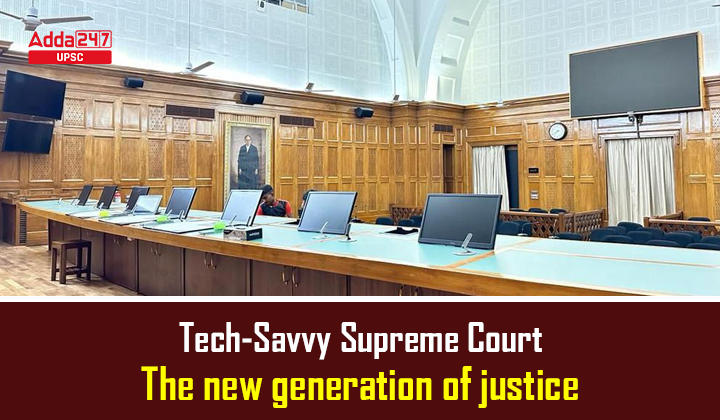Table of Contents
Why Tech-Savvy Supreme Court in News?
Under the dynamic vision of the Hon’ble the Chief Justice of India, Dr. Dhananjaya Y Chandrachud, a series of futuristic upgrades have been implemented in the Supreme Court of India which reopened on 3 July 2023, after getting a digital makeover with a sight of futuristic upgrades in the form of paperless and digitalized courtrooms.
Advent of Technology in Judiciary
- E-governance in the field of judiciary began in the late 1990s and started accelerating after the IT Act of 2000
- In 2018, in Swapnil Tripathi vs Supreme Court Of India, the Supreme Court allowed the live-streaming of cases of constitutional and national importance.
- The latest Vision Document for Phase III of the e-Courts Project was introduced during the Covid-19 pandemic to address the judiciary’s digital deprivation.
- Recently, the Law Minister has said that for implementing phase two of the eCourts project, there is a need to adopt new, cutting-edge technologies of Machine Learning (ML) and Artificial Intelligence (AI) to increase the efficiency of the justice delivery system
Features of Digital Courtrooms:
- Paper-less courtrooms
- Installation of a state-of-the-art Digital Video Conferencing (VC) and Sound system
- Cable cubbies have been integrated into these courtrooms
- LED video walls
- Document cameras have been installed
- Software is also installed to facilitate the upload of reference materials and citations and provide an e-pass facility to access the premises
Merits of Digital Courtrooms:
- This system is being implemented as part of green initiatives for the optimum use of technology in justice delivery systems
- Paper-less operations will make it eco-friendly
- Video walls will increase the visual impact of evidence
- The document camera will enable the real-time display of physical documents
- It will facilitate the seamless sharing of important legal material and evidence
- Will try to solve pendency issues in courts, increasing their efficiency
- Will increase the accessibility of courts ensuring last-mile delivery of justice
Other steps were taken by Judiciary in the direction:
Launch of eSCR, Advocate Appearance portal, online RTI portal, and implementation of e office-module in the Registry are some of the other important e-initiatives that the Supreme Court has undertaken.
Conclusion
Such digital transformation in the field of the judiciary is a positive step towards a better future of justice. Considering its potential to refine and define the justice-delivery system can be indeed labeled as a new generation of justice.
UPSC Exam Relevance
- GS-2: Important aspects of governance, transparency and accountability, e-governance- applications, models, successes, limitations, and potential; citizens charters, transparency & accountability, and institutional and other measures.
- GS-3: Science and Technology- developments and their applications and effects in everyday life.



 TSPSC Group 1 Question Paper 2024, Downl...
TSPSC Group 1 Question Paper 2024, Downl...
 TSPSC Group 1 Answer key 2024 Out, Downl...
TSPSC Group 1 Answer key 2024 Out, Downl...
 UPSC Prelims 2024 Question Paper, Downlo...
UPSC Prelims 2024 Question Paper, Downlo...
